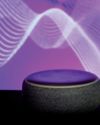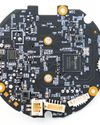
Weather stations may be custom-built to measure ambient conditions and phenomena such as temperature, humidity, barometric pressure, rainfall, solar radiation, and UV index, along with wind speed and direction. Many inspiring reviews cover offthe-shelf sensors that may achieve such diverse measurements. They include selection criteria and comparative analysis of those sensors, to help readers integrate them into their own weather stations.
As an enthusiast of DIY, microcontroller-based projects, I researched the Arduino forum for ideas on building weather stations.
I landed on a set of technical difficulties that mainly focus on moving parts of such projects specifically concerned with wind speed and direction. The outcome of my research was the project described here-to build an anemometer (Figure 1) with building blocks that are inexpensive and handy, with durability in mind.
for In this project, I am building an anemometer my home, using unconventional components. For wind speed measurement, I am implementing two alternate constructsone based on a water flow sensor, and the other using a drone's coreless motor run as a generator-both of which would react to open airflow. Rotating each construct freely by the wind or at will using a stepper motor determines wind direction, sensed by an encoder switch.
I am exploiting ball bearings in a novel way to build my own slip ring. By doing this, I successfully accomplished two things at one time: smooth rotation of the wind direction mast and achieving electrical connectivity between the outer stationary ring (wired to an MCU) and the inner rotating ring (wired to the water flow sensor on top of a weather station's mast).
In this article, I describe how I used sensors and actuators out of their conventional scope of application, to solve some of the problematic areas surrounding DIY anemometers, and to demonstrate how simple craftsman effort can help realize the final product.
この記事は Circuit Cellar の December 2024 版に掲載されています。
7 日間の Magzter GOLD 無料トライアルを開始して、何千もの厳選されたプレミアム ストーリー、9,000 以上の雑誌や新聞にアクセスしてください。
すでに購読者です ? サインイン
この記事は Circuit Cellar の December 2024 版に掲載されています。
7 日間の Magzter GOLD 無料トライアルを開始して、何千もの厳選されたプレミアム ストーリー、9,000 以上の雑誌や新聞にアクセスしてください。
すでに購読者です? サインイン

New TI MCUs Enable Edge AI and Industry-Leading Real-Time Control to Advance Efficiency, Safety, and Sustainability
Texas Instruments (TI) introduced two new series of real-time microcontrollers that deliver advancements to help engineers achieve more intelligent and secure processing in automotive and industrial applications.

Using Amazon Alexa to Control Custom IoT Gadgets
In part two of his article, Brian describes integrating custom IoT gadgets with Amazon Echo using emulation to receive spoken alarms. In part one, he used emulation and Arduino Cloud services as a middleman.

Holiday Hangover Hardware Hacking
Having too much cheer during the holidays? In this month's article, Colin offers a diversion from the jolly season by urging developers to retreat to the basement to brush up on hardware hacking skills. He shows how a low-cost Raspberry Pi Pico and a TP-Link Tapo C200 smart IP camera could become the next automated bird deterrent or a home automation server.

Datasheet: Microamps Per Megahertz Ultra-Low Power MCUs Minimize Current Consumption
How do chip makers differentiate if many ultra-low power MCUs on the market feature the same processor core? The peripherals and different power states offer various ways to manage current consumption down to microamps per megahertz.

Smart Home Lock Down Matter Provides Security Blanket
As more devices in the smart home connect to the Internet, they become increasingly vulnerable to outside attacks. Developers can now add the latest security measures to their Smart Home devices through Matter.

Basic Pulse Circuits
In part one of a three-part series, Wolfgang wrote how basic pulse circuits help digital circuits, such as embedded boards with ARM processors, deal with pulse trains or bursts of pulses from the outside. In Part 2, he dives into enabling flip-flops, timing parameters, and synchronization, design tasks needed to capture, detect, and filter pulses.

Building a Wi-Fi Router Watchdog
Dev created a watchdog for a Wi-Fi extender using a Raspberry Pi Pico. This monitors Wi-Fi connectivity for his smart home lighting system, which would require a reset twice a year due to rapid power interruptions.

Create Your Own PCBs with a CNC Milling Machine
Using KiCad, CopperCAM, and Candle Software

Performance Bottlenecks in Embedded Linux Solutions Analysis, Identification, and Mitigation
Good performance is a requirement for every technology, and system designers rely on operating systems to ensure fast and smooth transitions in critical applications. Fortunately, Pedro writes, the embedded Linux OS offers ways for finding, analyzing and mitigating performance bottlenecks so embedded systems can deliver the speed and efficiency that end users expect.

Renesas New RA8 Entry-Line MCU Groups Brings High Performance of Arm Cortex-M85 Processor to Cost-Sensitive Applications with Market-Leading CoreMark Performance
Renesas Electronics Corp., a premier supplier of advanced semiconductor solutions, introduced the RA8E1 and RA8E2 microcontroller (MCU) groups, extending the industry's most powerful series of MCUs.